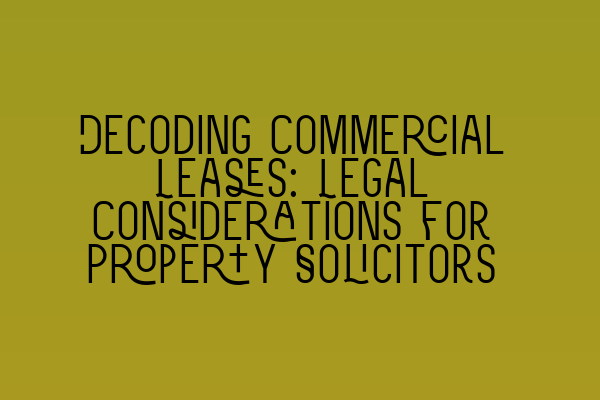Decoding Commercial Leases: Legal Considerations for Property Solicitors
Commercial leases play a crucial role in the world of property law. Whether you’re a property solicitor or a law student preparing for the SQE exam, understanding the intricacies of commercial leases is essential for success in this field. In this article, we will decode the legal considerations surrounding commercial leases, providing you with valuable insights and knowledge to navigate this complex area of law.
1. The Basics of Commercial Leases
Before we dive into the legal aspects, let’s start with the basics. A commercial lease is a legally binding agreement between a landlord and a tenant for the rental of a commercial property. It outlines the rights and obligations of both parties throughout the lease term.
Commercial leases can vary significantly in their terms and conditions depending on factors such as the type of property, the length of the lease, and the specific requirements of the landlord and tenant. As a property solicitor, it’s crucial to carefully review the lease agreement and ensure all legal considerations are addressed.
2. Key Provisions in Commercial Leases
When analyzing a commercial lease, several key provisions require careful attention. Let’s take a closer look at some of the most important legal considerations:
a) Rent and Rent Review
The rent clause is the heart of any commercial lease. It sets out the amount of rent to be paid, the frequency of payments, and any provisions for rent review. As a property solicitor, you must ensure that the rent provisions are fair and reasonable for both parties. Additionally, understanding the mechanisms and procedures for rent review is crucial to protect your client’s interests.
b) Repair and Maintenance
The repair and maintenance clause outlines who is responsible for maintaining and repairing the property. It’s crucial to carefully review this provision to determine the extent of the tenant’s obligations and any potential liabilities. As a property solicitor, you should advise your client on their rights and obligations regarding repairs and maintenance.
c) Break Clauses
Break clauses provide flexibility for both landlords and tenants. They allow either party to terminate the lease before the end of the fixed term under certain conditions. Understanding the intricacies of break clauses and their potential implications is vital in drafting and negotiating commercial leases.
d) Alienation and Subletting
The alienation and subletting clause regulates the tenant’s ability to assign or sublet the property to a third party. It’s important to carefully review this provision to ensure the landlord’s consent is required, and any necessary conditions or restrictions are appropriately stated. As a property solicitor, you should advise your client on their rights and obligations related to alienation and subletting.
e) Use and Planning Consent
The use provision specifies the permitted use of the commercial property. It’s crucial to ensure that the tenant’s desired use aligns with the planning permission and any other restrictions imposed by local authorities. As a property solicitor, you must carefully review this provision to avoid any future planning disputes.
f) Termination and Renewal
The termination and renewal provisions dictate what happens at the end of the lease term. Understanding the implications of these provisions is essential to protect your client’s interests. As a property solicitor, you should advise your client on the necessary steps for termination or renewal and any potential implications.
3. Additional Legal Considerations
While the key provisions we discussed above are crucial, there are several other legal considerations to bear in mind when analyzing commercial leases:
a) Statutory Requirements
Ensure that the lease adheres to all relevant statutory requirements, including those related to health and safety, fire regulations, and environmental standards. Failure to comply with these requirements can result in legal consequences for your client.
b) Guarantors and Security Deposits
Consider whether a guarantor or security deposit is necessary to provide additional security for the landlord. Ensure that the relevant provisions are clear and robust to protect your client’s interests.
c) Insurance
Review the insurance provisions to ensure that the appropriate types and levels of insurance are required. Consider advising your client on the importance of obtaining comprehensive insurance coverage.
d) Dispute Resolution
Review the dispute resolution provisions to determine the mechanisms for resolving any future disputes. Consider advising your client on the benefits of alternative dispute resolution methods such as mediation or arbitration.
4. Conclusion
Decoding commercial leases requires a deep understanding of the legal considerations involved. By paying attention to key provisions and additional legal considerations, property solicitors can effectively navigate this complex area of law and protect their client’s interests.
If you’re preparing for the SQE exam, developing your legal research skills is crucial for success. Check out our article on “Unlocking Legal Research Skills for SQE Success” for valuable insights.
To build a solid foundation for your SQE exam preparation, it’s important to have the right textbooks. Explore our recommendations in “Essential SQE Textbooks: Building a Solid Foundation for Exam Prep”.
Understanding the stages of the SQE exam is crucial for success. Check out our article on “Unraveling the SQE Stages: A Roadmap to Success” to ensure you’re on the right track.
Planning to take the SQE exam? Consider the convenience of different exam centers. Learn more in our article on “Test Centers for SQE: Convenient Locations for the Exam”.
If you’re transitioning from the LPC to the SQE, understanding the new qualification pathway is crucial. Explore our insights in “Transitioning from LPC to SQE: Navigating the New Qualification Pathway”.
